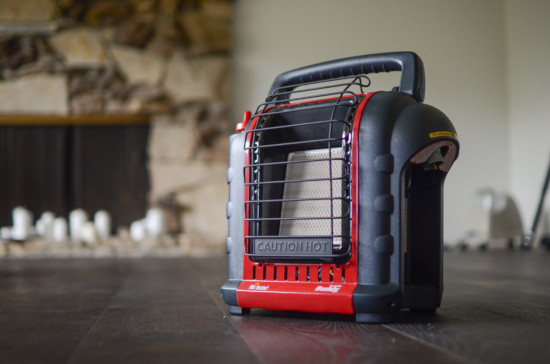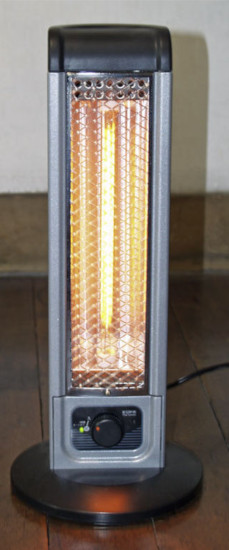The 7 Best Ways to Heat Your Garage in the Winter
Last Updated on December 11, 2021

Do you live in the northern part of the United States? If you do, and you work in your garage, you will need some sort of heat during the winter months. Whether you have a workshop out there for working on wood, cars, or crafts, or an expensive car that you don’t want to subject to the cold, the typical garage is too cold to work in during the winter months.
There are many different ways to create heat, so what is the best way for you to heat your garage? How warm do you want it to get? Will you be keeping it at a steady temperature, only raising it when you need it, and how much do you want to spend? We are going to break down the best seven ways to get the heat you want.
1. Insulate:
Insulation is what holds heat inside. You can heat your garage until the cows come home without any effect if you don’t have proper insulation to keep that heat inside. It would be like trying to heat the outdoors. Make sure to insulate the garage doors, as well as the walls and ceiling. You can lose just as much air through them as you will uninsulated walls and ceilings.
2. Check Doors and Windows:
Air can escape through cracks around windows and doors. Check all the seals on your doors to make sure they have a tight, leak-proof fit.
Windows are a different story. You can keep from losing heat from around your windows in one of two ways. You can replace them all with good thermal insulated ones, but that can be very expensive. If you want to keep your garage at the same temperature at all times and use it as if it was almost an extension to your house, this may be your best bet.
Most people, however, only heat the garage when they are going to be using it. A more economical, yet effective, way to help with heat loss is to apply clear plastic shrink film over your windows. All you need to install it is the kit, scissors, and a hair dryer. The heat from the hair dryer tightens the plastic up and gives it a better seal. You can get these plastic shrink film kits at any hardware store.

3. Heated Floors:
Another great way to add heat to your garage is in-floor heat. The coils are laid down, and then concrete is poured over them. Obviously, the best time to lay heated floors is when you are first building your garage.
The only way to have heated flooring on a pre-existing garage is to tear up the old concrete, lay the coils, and repour the floor. This can be expensive and is only worth the extra money if you are going to maintain a steady temperature, or use the heater a lot.

Image credit: Your Best Digs, Flickr
- Even heat distribution
- Must be laid underneath concrete
4. Forced Air Gas Heaters:
Forced air heaters run on either natural or propane gas. They are the closest you can get to heat that will operate like the furnace in your house. Even though they run on gas, you will still need electrical power to operate the thermostat.
Though forced air heaters can heat a large area efficiently and are less expensive than infrared heaters, they are rather costly to run. They are usually mounted on the ceiling and blow the air down, but heat rises, so it will always be a little cooler on the floor. Take into account how you will be using this space before you make your purchase.
Forced air heaters also blow a lot of air and dust. If you do any staining or painting in your garage, this may not be your best bet. The dust particles will get into your paint or stain and ruin your smooth surface.
- Less out-of-pocket expense
- Most expensive to run
- Blows dust around
- Floor stays cooler
- Noisy
- Longer recovery time
5. Infrared Heaters:
Infrared heaters cost about double what forced air heaters cost, but they are more cost-effective to operate in the long run. You can get ones that run on electricity or gas. You can use these heaters in one of two ways. You can hang them from a ceiling to get a broader range of coverage, but the most economical way is to have them on the floor pointing in the direction that you want the heat.
Infrared heaters don’t heat the whole space as forced air heaters do. They heat whatever is directly in front of them. That could be a car, the floor, or even you. The issue arises when you have more people or different areas that you need to heat. Maybe you are making something out of wood, and your saw is on one side of the room while your sander is on the other. It is impossible to heat both of these areas at once with the same heater. You may require more than one unit to get the coverage you need.
Infrared heaters are better for people who do a lot of staining or painting, though. They work a lot like a heat lamp, so there is no dirt being blown around to get stuck in your wet surfaces.

Image credit: aquila2664, Wikipedia
- Even heat distribution
- More cost-efficient to run
- Less air movement
- Pretty quiet
- Quicker heat recovery
- Most expensive to run
- Floor stays cooler
- Noisy
- Longer recovery time
6. Portable Electric Heaters:
Portable electric heaters are very efficient, since they use all the power that they get to heat the area around them. The problem with these heaters is that many of them have the heated coils behind cheap mesh, so it would be easy for something small to get inside and touch the hot elements. Even if you don’t touch the electrical coils directly, the mesh gets hot to the touch.
You can also get radiator-style electric heaters. While these are safer in the sense that they don’t have any electric coils, they can get hot. There is a much higher chance of getting burnt with portable electric heaters than with any other kind of temporary heat solutions.

Image credit: Your Best Digs, Flickr
- Steady heat source
- Directional heat only
- Can get hot
7. Radiant Heating:
Radiant heating is a system where the heating elements are laid under, or inside of, a surface, heating that surface directly. That surface gets warm and radiates heat into the rest of the room.
There are different kinds of radiant heat:

Image credit: Nuorese 95, Wikimedia
- Underfloor:
Radiant floor heat is the same as a heated floor. The heating coils must be laid underneath your slab of concrete.
- Wall:
The heating panels can be attached to the studs that support your house, inside your walls.
- Ceiling Panels:
The heating element is inside the panels in a drop ceiling. These are a very effective way to heat and look nice too.
Radiant heating is more effective and efficient than any of the other types of heaters because they spread the heat equally throughout the room. They also don’t blow around dust particles to float in the air.
Another big plus for radiant heat is that is can get its power from multiple types of power sources. Although you could use electricity, they can also operate from any kind of boiler, or even from solar panels. These different power sources are more cost-effective, so they help keep money in your pocket.
- Even heat distribution
- Most economical to run
- Must be laid during construction
- High out-of-pocket costs
There are many ways to heat your garage. The first step in deciding which way to heat it is to know what you want to use it for, and how you want to use it. If you are a tinkerer and wish to use it now and then while you are out there doing a project, then a more economical and portable unit may be for you. If you are a mechanic and use the garage often to work on cars, but it isn’t a daily thing, you may choose forced air. If you have your garage set up as a room to do woodwork in and you will use it all day, every day, you may want something more like radiant heat.
No matter what you use your garage for, you need heat to be comfortable working in it during the winter months. Hopefully, we have given you enough information on the different types of heat that you can make the best-educated decision for your needs.
Sources used:
https://www.energy.gov/energysaver/home-heating-systems/radiant-heating
